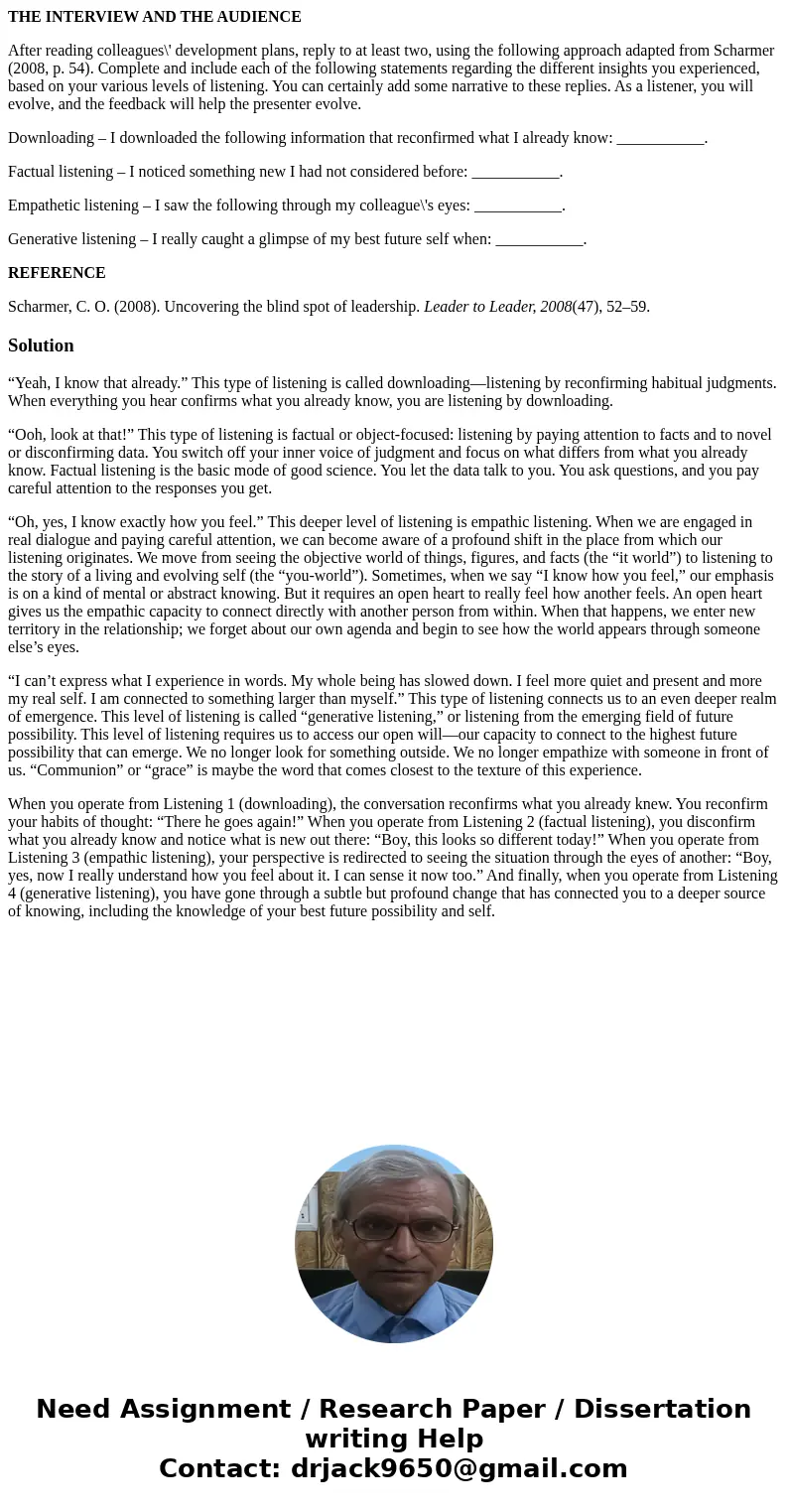THE INTERVIEW AND THE AUDIENCE After reading colleagues deve
THE INTERVIEW AND THE AUDIENCE
After reading colleagues\' development plans, reply to at least two, using the following approach adapted from Scharmer (2008, p. 54). Complete and include each of the following statements regarding the different insights you experienced, based on your various levels of listening. You can certainly add some narrative to these replies. As a listener, you will evolve, and the feedback will help the presenter evolve.
Downloading – I downloaded the following information that reconfirmed what I already know: ___________.
Factual listening – I noticed something new I had not considered before: ___________.
Empathetic listening – I saw the following through my colleague\'s eyes: ___________.
Generative listening – I really caught a glimpse of my best future self when: ___________.
REFERENCE
Scharmer, C. O. (2008). Uncovering the blind spot of leadership. Leader to Leader, 2008(47), 52–59.
Solution
“Yeah, I know that already.” This type of listening is called downloading—listening by reconfirming habitual judgments. When everything you hear confirms what you already know, you are listening by downloading.
“Ooh, look at that!” This type of listening is factual or object-focused: listening by paying attention to facts and to novel or disconfirming data. You switch off your inner voice of judgment and focus on what differs from what you already know. Factual listening is the basic mode of good science. You let the data talk to you. You ask questions, and you pay careful attention to the responses you get.
“Oh, yes, I know exactly how you feel.” This deeper level of listening is empathic listening. When we are engaged in real dialogue and paying careful attention, we can become aware of a profound shift in the place from which our listening originates. We move from seeing the objective world of things, figures, and facts (the “it world”) to listening to the story of a living and evolving self (the “you-world”). Sometimes, when we say “I know how you feel,” our emphasis is on a kind of mental or abstract knowing. But it requires an open heart to really feel how another feels. An open heart gives us the empathic capacity to connect directly with another person from within. When that happens, we enter new territory in the relationship; we forget about our own agenda and begin to see how the world appears through someone else’s eyes.
“I can’t express what I experience in words. My whole being has slowed down. I feel more quiet and present and more my real self. I am connected to something larger than myself.” This type of listening connects us to an even deeper realm of emergence. This level of listening is called “generative listening,” or listening from the emerging field of future possibility. This level of listening requires us to access our open will—our capacity to connect to the highest future possibility that can emerge. We no longer look for something outside. We no longer empathize with someone in front of us. “Communion” or “grace” is maybe the word that comes closest to the texture of this experience.
When you operate from Listening 1 (downloading), the conversation reconfirms what you already knew. You reconfirm your habits of thought: “There he goes again!” When you operate from Listening 2 (factual listening), you disconfirm what you already know and notice what is new out there: “Boy, this looks so different today!” When you operate from Listening 3 (empathic listening), your perspective is redirected to seeing the situation through the eyes of another: “Boy, yes, now I really understand how you feel about it. I can sense it now too.” And finally, when you operate from Listening 4 (generative listening), you have gone through a subtle but profound change that has connected you to a deeper source of knowing, including the knowledge of your best future possibility and self.

 Homework Sourse
Homework Sourse